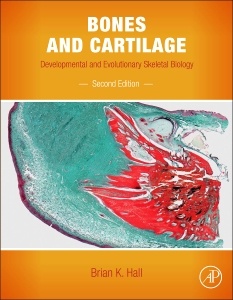Description
Bones and Cartilage (2nd Ed.)
Developmental and Evolutionary Skeletal Biology
Author: Hall Brian K.
Language: English
Subjects for Bones and Cartilage:
Keywords
bone and cartilage; development and evolution of the skeleton; growth and patterning; embryos; evolutionary skeletal biology; normal variation and variability; neomorphs; atavisms; origination of cartilage; phylogenetic; cellular and genetic data; stem cells; mesenchymal stem cells; genetic engineering of cartilage; and stem cell niche
920 p. · 21.4x27.6 cm · Hardback
Description
/li>Contents
/li>Readership
/li>Biography
/li>Comment
/li>
Bones and Cartilage provides the most in-depth review and synthesis assembled on the topic, across all vertebrates. It examines the function, development and evolution of bone and cartilage as tissues, organs and skeletal systems. It describes how bone and cartilage develop in embryos and are maintained in adults, how bone is repaired when we break a leg, or regenerates when a newt grows a new limb, or a lizard a new tail.
The second edition of Bones and Cartilage includes the most recent knowledge of molecular, cellular, developmental and evolutionary processes, which are integrated to outline a unified discipline of developmental and evolutionary skeletal biology. Additionally, coverage includes how the molecular and cellular aspects of bones and cartilage differ in different skeletal systems and across species, along with the latest studies and hypotheses of relationships between skeletal cells and the most recent information on coupling between osteocytes and osteoclasts All chapters have been revised and updated to include the latest research.
Part I Vertebrate Skeletal Tissues1. Vertebrate Skeletal Tissues2. Bone3. Vertebrate Cartilages
Part II Origins and Types of Skeletal Tissues4. Invertebrate Cartilages, Notochordal Cartilage and Cartilage Origins5. Intermediate Tissues6. Lessons from Fossils
Part III Unusual Modes of Skeletogenesis7. Horns and Ossicones8. Antlers9. Tendon Skeletogenesis and Sesamoids
Part IV Stem and Progenitor Cells10. Embryonic Stem and Progenitor Cells11. Stem and Progenitor Cells in Adults
Part V Skeletogenic Cells12. Bipotential Osteochondroprogenitor Cells13. Dedifferentiation of Chondrocytes and Endochondral Ossification14. Dedifferentiation and Stem Cells: Regeneration of Urodele Limbs and Mammalian Fingertips15. Cells to Make and Cells to Break
Part VI Embryonic Origins16. Skeletal Origins: Somitic Mesoderm, Vertebrae, Pectoral and Pelvic Girdles17. Skeletal Origins: Neural Crest Cells18. Epithelial–Mesenchymal Interactions initiate Skeletogenesis
Part VII Getting Started19. The Membranous Skeleton: Condensations20. From Condensation to Differentiation21. Skulls, Eyes and Ears: Condensations and Tissue Interactions
Part VIII Similarity and Diversity22. Hondrocyte Diversity23. Cartilage Diversity24. Osteoblast and Osteocyte Diversity and Osteogenesis in vitro25. Diversity of Bone as a Tissue and as an Organ
Part IX Maintaining Cartilage in Good Times and in Bad26. Maintaining Differentiated Chondrocytes through Cell–Matrix Interactions27. Maintenance Awry – Chondrodysplasias and Achondroplasia28. Restarting Mammalian Articular Chondrocytes29. Repair of Fractures and Regeneration of Growth Plates
Part X Growing Together and Growing Apart30. Initiating Skeletal Growth31. Growth and Morphogenesis of Long Bones32. Long Bone Growth: A Case of Crying Wolf?
Part XI Staying Apart33. The Temporomandibular Joint and Cranial Synchondroses34. Sutures and Craniosynostosis
Part XII Limb Buds35. The Mesodermal Limb Field and the Apical Epithelial Ridge36. Adding or Deleting an Apical Epithelial Ridge37. Limb Buds in Limbed and Limbless Tetrapods
Part XIII Limbs and Limb Skeletons38. Axes and Polarity of Limb Buds and Limbs39. Patterning and Shaping Limb Buds and Limb Skeletons40. Before Limbs There Were Fins
Part XIV Backbones and Tails41. Vertebral Chondrogenesis: Cell Differentiation and Morphogenesis42. Relationships between Notochord and Vertebral Cartilage43. Tail Buds, Tails and Taillessness
Part XV Evolutionary Skeletal Biology44. Variation45. Variation Outside the Norm: Neomorphs and Atavisms
- Offers complete coverage of every aspect of bone and cartilage, with updated references and extensive illustrations
- Integrates development and evolution of the skeleton, as well a synthesis of differentiation, growth and patterning
- Treats all levels from molecular to clinical, embryos to evolution, and covers all vertebrates as well as invertebrate cartilages
- Includes new chapters on evolutionary skeletal biology that highlight normal variation and variability, and variation outside the norm (neomorphs, atavisms)
- Updates hypotheses on the origination of cartilage using new phylogenetic, cellular and genetic data
- Covers stem cells in embryos and adults, including mesenchymal stem cells and their use in genetic engineering of cartilage, and the concept of the stem cell niche
These books may interest you

Vertebrate Skeletal Development 166.19 €

Bone and Cartilage Regeneration 168.79 €


